Ellsworth, Kansas,
was one of our early destinations in our genealogical
journey. We reached Ellsworth in June, 2001, when the winter wheat was ready for harvest.
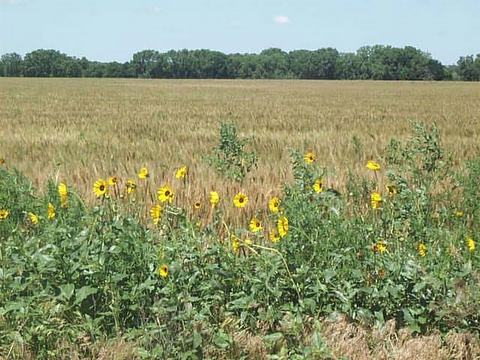 Winter wheat and
wild sunflowers.
The combine drivers who move from farm to farm were
still a few towns away, but due shortly. In Ellsworth County, wheat,
corn, beans and sunflowers seem to be the
principal crops, but there are plenty of cattle ranches as well.
Winter wheat and
wild sunflowers.
The combine drivers who move from farm to farm were
still a few towns away, but due shortly. In Ellsworth County, wheat,
corn, beans and sunflowers seem to be the
principal crops, but there are plenty of cattle ranches as well.
Elsa's maternal grandmother,
Ella Rowe,
grew up in Wilson, Kansas. Like many young people of the
1880s who lived on outlying farms, Ella and her sisters came to
Ellsworth for high school, boarding with families in town.
One of Ella's teachers was Charles Cadwell, who was working his way
through college by teaching in his old school. Just as in a
romantic novel, Ella and Charles fell in love.
We had very little information about the
family, which made this a good place to start, because each nugget of
information gave us new names and relationships to explore.
Our first stop in Ellsworth was
the Historical Society.
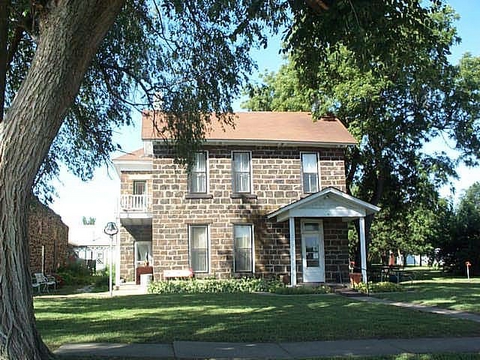 Ellsworth
Historical Society
We found its home in a trim small stone
house near the center of town (almost everything is near the center of
town). When we mentioned the name Cadwell to the historian,
she smiled, disappeared into a back room, and returned with a photo of
the entire Cadwell family -- Charles, his brothers and sisters, and his
parents. It had been taken about 1895, when all of the
children were grown or almost grown and the parents looked
mature. We'd never seen this photo before. Later we learned
that just about everybody in the family has a copy and still later we
found Ella's own copy, buried in an old scrapbook. In
genealogy discoveries can come in any order.
Ellsworth
Historical Society
We found its home in a trim small stone
house near the center of town (almost everything is near the center of
town). When we mentioned the name Cadwell to the historian,
she smiled, disappeared into a back room, and returned with a photo of
the entire Cadwell family -- Charles, his brothers and sisters, and his
parents. It had been taken about 1895, when all of the
children were grown or almost grown and the parents looked
mature. We'd never seen this photo before. Later we learned
that just about everybody in the family has a copy and still later we
found Ella's own copy, buried in an old scrapbook. In
genealogy discoveries can come in any order.
We stared and studied and began
to
become acquainted with this family, and before we left Ellsworth we had
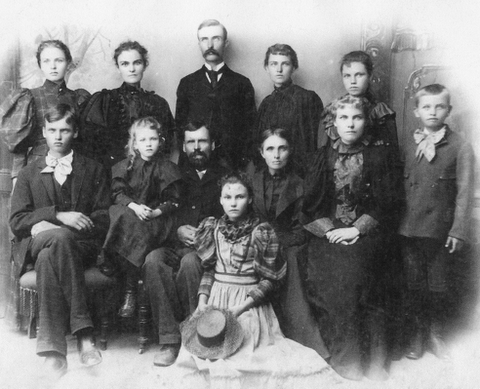 Simon Cadwell's family 1892
added many stories to our files. Our new friend,
the historian, pointed us to the owner of a Western store, and to
Elsa's mother's first cousin Nancy who still lives in Ellsworth. We
visited both, soaking up stories and gossip and speculation and making
new friends.
Simon Cadwell's family 1892
added many stories to our files. Our new friend,
the historian, pointed us to the owner of a Western store, and to
Elsa's mother's first cousin Nancy who still lives in Ellsworth. We
visited both, soaking up stories and gossip and speculation and making
new friends.
All of the Cadwells were born
in a sod
house, at least that is the way the newspaper obituaries and some
family memories go. At the courthouse we found the local land
records and identified the farm where the Cadwells had lived.
Thanks to cousin Nancy, who seems to be friends with everybody
in
Ellsworth, we got permission to visit the land, which is now just an
overgrown field. At the end of a barely visible dirt
track we found the remains of the house which had been built for the
growing family over a hundred years ago.
 Simon Cadwell's home
Simon Cadwell's home
It was a large old stone house designed and built by the famous (in
Ellsworth) "Z" Jackson. Great-grandfather Simon Cadwell had to wait
until Jackson had completed the Ellsworth Opera House for his fine new
mansion to be erected. While waiting for the stone house the family did
indeed live in a "soddie," and that was the preferred story for pioneer
historians!
Ellsworth County is rectangular, 30 miles wide by 24 miles
high, or exactly 20 Townships, each 6 miles on a side. The two largest
towns are Ellsworth, population 6000, and Wilson, population 2000.
There are three smaller towns: Kanopolis, about 700, Holyrood, perhaps
500, and Lorraine, maybe 300. Carneiro (Portuguese for sheep
fold) might have 100 souls, and the rest of Ellsworth County lives on
their farms and ranches. The most impressive establishment is
a large natural gas compression station; elsewhere, a few oil
wells pump along in the middle of fields. Over the years the
agricultural output has grown steadily while the population has
steadily declined.
The history of this part of the world is pretty simple. It
was Indian Territory until the U.S. decided to open it up for
settlement in 1862. The railroads came through, putting up
small towns for the workers along the right-of-way; some remained as
loading stations for cattle on the way to market. Cavalry forts were
built to protect the railroads and early settlers, (or to drive out the
Indians,
depending on your view of history.) Saloons were the
first commercial establishments in these towns. The early
inhabitants were pretty lawless.
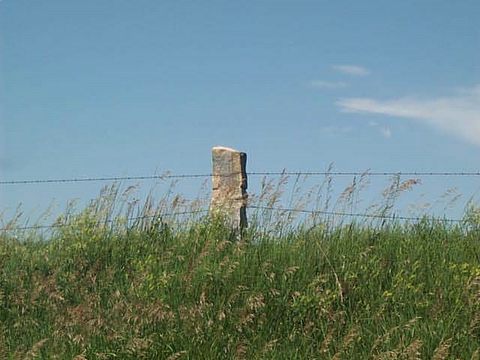 Granite fence post
Texas cowboys drove their herds of longhorns along
the Chisholm Trail, despite the objections of the local Kansas ranchers
who feared ticks
(longhorns were immune, domestic cattle sickened) and tried to guard
their water holes for their own cattle. Other
settlers came to farm the land, putting up fences and planting crops.
On the treeless prairie, fence posts were cut from granite. Droughts,
long winters in which entire cattle herds
froze to death, prairie fires and plagues of grasshoppers -- all of the
disasters Laura Ingalls Wilder and Willa Cather have described befell
the Kansas ranchers and farmers. By the turn of the century
it became fashionable for wealthy easterners to buy a Kansas ranch and
invite friends to play cowboy over the summer. A few
remained as serious landowners. Nowadays Ellsworth folks grow
winter wheat and feed crops, and raise some beef cattle.
Granite fence post
Texas cowboys drove their herds of longhorns along
the Chisholm Trail, despite the objections of the local Kansas ranchers
who feared ticks
(longhorns were immune, domestic cattle sickened) and tried to guard
their water holes for their own cattle. Other
settlers came to farm the land, putting up fences and planting crops.
On the treeless prairie, fence posts were cut from granite. Droughts,
long winters in which entire cattle herds
froze to death, prairie fires and plagues of grasshoppers -- all of the
disasters Laura Ingalls Wilder and Willa Cather have described befell
the Kansas ranchers and farmers. By the turn of the century
it became fashionable for wealthy easterners to buy a Kansas ranch and
invite friends to play cowboy over the summer. A few
remained as serious landowners. Nowadays Ellsworth folks grow
winter wheat and feed crops, and raise some beef cattle.
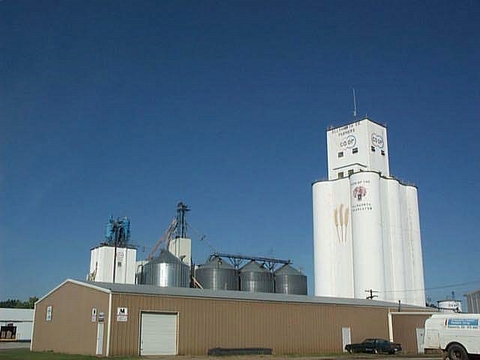 Ellsworth Grain Elevator
Nancy shared with us her recollections of farm and ranch life
and some choice Cadwell family stories. We now know how to detect
rye amidst the winter wheat (it sticks up higher), and we
understand how a life of farming marries you to the land.
Nancy took us to the Buckeye Cemetery, out in the
country on a dirt road, but immaculately kept, with solid granite
stones, and filled with family and friends of old.
Ellsworth Grain Elevator
Nancy shared with us her recollections of farm and ranch life
and some choice Cadwell family stories. We now know how to detect
rye amidst the winter wheat (it sticks up higher), and we
understand how a life of farming marries you to the land.
Nancy took us to the Buckeye Cemetery, out in the
country on a dirt road, but immaculately kept, with solid granite
stones, and filled with family and friends of old.
Charles and Ella Cadwell raised their family in Cleveland,
Ohio, and Elsa grew up ignorant of her rich Kansas heritage. In
retirement we began to piece together our family history.
 Winter wheat and
wild sunflowers.
The combine drivers who move from farm to farm were
still a few towns away, but due shortly. In Ellsworth County, wheat,
corn, beans and sunflowers seem to be the
principal crops, but there are plenty of cattle ranches as well.
Winter wheat and
wild sunflowers.
The combine drivers who move from farm to farm were
still a few towns away, but due shortly. In Ellsworth County, wheat,
corn, beans and sunflowers seem to be the
principal crops, but there are plenty of cattle ranches as well. Ellsworth
Historical Society
Ellsworth
Historical Society Simon Cadwell's family 1892
Simon Cadwell's family 1892 Simon Cadwell's home
Simon Cadwell's home Granite fence post
Granite fence post Ellsworth Grain Elevator
Ellsworth Grain Elevator